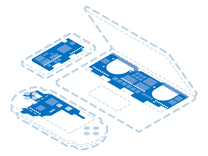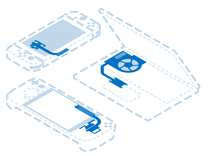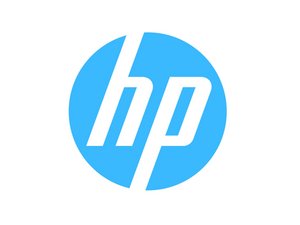You're seeing solutions for HP Laptop. Select your model to find parts for your device.
The Basics
Before undertaking any of the more time-consuming solutions below, here are a few fundamentals to get you started.
- Restart your computer. It's Troubleshooting 101 for good reason. Restarting your laptop correctly (rather than by crash or boot loop) finalizes any pending repairs and restarts all systems services. Use the restart option in the Start Menu.
- Check System Resources: Open the Task Manager to identify resource-intensive applications and processes affecting system performance or to identify which component might be your hardware bottleneck.
- Install pending updates. Vendors often implement patches or updates to software to improve responsiveness or lower resource overhead. Windows updates can be found in Settings > Updates and Security.
- Change performance settings. Opting to select battery-saving modes can negatively impact system performance. Limiting the power components can consume maximizes battery life, which also limits their performance. Select Start > Settings > System > Power & battery. From there, select either the Balanced or the Performance power plan.
- Click the battery icon in the system tray to change this quickly on the fly. Use the slider to optimize performance or battery life.
Causes
It isn't just the apps you intend to run sucking up system resources. So does any nefarious software you may have picked up on your internet travels. Malware can cause a system to perform poorly for many reasons, but whatever the cause, you'll need to
- Open Task Manager to check system utilization. You can access this by right-clicking the Windows Start Menu or pressing Ctrl + Shift + Esc on your keyboard.
- Check the processes to see if anything here is consuming a large amount of system resources. Some critical thinking and internet research may be needed to determine what's what.
- Run a scan using any Antivirus program you may have installed. If you do not have dedicated security software, use Windows Defender. It can be accessed from the Windows Security App in most versions of Windows.
- Want a second opinion about your results? Malwarebytes or ESET Online Scan are free programs providing excellent malware scanning techniques.
- Remove anything the scan finds. It may also recommend a restart to complete the removal.
- Beware that some supposed anti-malware programs are malware themselves. Using additional system resources further drains your battery. Research good free options, or use the program preinstalled on your system (look for Windows Defender if you're on Windows 8 or later).
Moving forward, follow best practices for internet safety. This will prevent you from accumulating more malware in the future:
- Use ad-blocking software like uBlock Origin to prevent ads from loading in your browser.
- Don't allow third-party websites to download software from your computer.
- Avoid pirating games or software. Sorry, internet BlackBeards, these usually are huge vectors for infection.
- Avoid scam emails and be highly suspicious of any attachments on all emails.
- Keep software up to date to get the latest security patches.
Despite the notion that more protection is better, making logical sense regarding antivirus software isn't the case. Antivirus can be a resource hog in the best of times, but having more than one installed can cause conflict. It may also utilize all your system resources to keep the system safe, leaving none for you to use.
- The best practice is to pick the one you like most and uninstall all others.
- Different programs have different benefits. If you're unsure which program to choose, research features and pitfalls before deciding.
A corrupt operating system means critical system files have become invalid or damaged. Usually, this occurs due to power loss during an update, the battery dying during use, or even a failed update. This can lead to odd behavior, including overall system slowness. Windows provides access to repair tools that correct these corruption issues.
- Right-click the Start Menu and select Command Prompt, Powershell, or Windows Terminal (Windows 8, 10, and 11 will provide different options).
- In the window that appears, type
sfc /scannow, then press enter. Once it has finished, it will tell you if it found errors and whether or not it could fix them. - Restart your system and rerun sfc to verify no further corruption has been found.
- If you continue to find corruption or slowness persists, run through the Windows Repair Guide. Be aware that it does use more command-line operations, so it will not be for everyone. However, software repairs can significantly improve system speed.
If you aren't concerned about losing your data, try the Nuke Everything approach and reinstall Windows.
- Windows 10 reset options are in Settings > Update & Security > Recovery.
- Try the Keep Data option first; this only reinstalls Windows and removes applications. You files
- For stubborn issues, use create a USB installer to install instead.

- No estimateModerate

- 30 minutesEasy
Although many HP laptops have competent hardware, you can only ask them to do so many things before they get overwhelmed and lock up. In some ways, it’s a lot like a human brain. Giving it one taxing thing to do is more accessible than giving it twelve things to do simultaneously, even if the twelve things are less demanding.
- Open Task Manager by pressing Ctrl + Shift + Esc to get a baseline for resource utilization. To see all the information, you may need to click More details at the bottom of the window.
- The Processes tab shows the use percentage for each major system component. Clicking the component's name will sort the list according to resource consumption.
- Skim the list for resource Logs or note if any component is maxed out. CPU and Disk are the most frequent culprits, but many open browser tabs will quickly eat up Memory.
- Close any apps hogging system components. You can force them to close by clicking End Task at the bottom right. Be sure to research processes before closing unfamiliar ones; many are Windows processes.
- Select the Startup tab and skim through the items there. Disable any that do not need to run when your laptop boots up.
- Cloud sync apps are often the culprit here. The best practice is to launch these as needed and use one for backup. That way, it doesn't back up the same file to several systems.
- If programs vital to your use case are the cause, consider adding additional RAM if you have that option. However, you may be relegated to swapping your motherboard for HP Laptop Motherboards.
- Video games are generally more demanding than productivity applications. Be sure your computer meets the minimum system requirements.

Find compatible replacement parts for your HP Laptop. All parts and fix kits are backed by the iFixit Quality Guarantee.
Computers generate a lot of heat whenever they are under significant processing stress. This is why most computers require a cooling system, such as a fan and heat sink, to cool the CPU. If your HP Laptop is overheating, it is designed to slow itself down to generate less heat. This is often referred to as Thermal Throttling.
- Check the temperature your hardware is reaching. Use Open Hardware Monitor or any of the other temperature monitoring software.
- If temperatures are high, even with nothing much running, it’s time for routine maintenance. Open your laptop, arm yourself with compressed air, and show the dust clinging to your fans who’s boss.
- Carefully inspect your laptop's vents and cooling system for dust or debris obstructing airflow.
- Use your laptop on a smooth, level surface. Surfaces like carpet or fabric can block your device's vents and restrict airflow.
- Consider using a cooling pad designated for laptops to improve ventilation and reduce the risk of overheating.
- To go the extra mile, reapplying thermal paste to your CPU (and GPU if your laptop has dedicated graphics hardware) can optimize thermal transfer to the heat sink and lower operating temperatures.
- In rare cases, your heat sink may need to be replaced. They don't fail often, but there will generally be visual indications when they do. Ensure no bends, kinks, or holes are in the attached pipes. Replace the HP Laptop Heat Sinks if necessary.

Find compatible replacement parts for your HP Laptop. All parts and fix kits are backed by the iFixit Quality Guarantee.
Occasionally, incorrect BIOS settings on an HP laptop can contribute to sluggish performance. Your laptop's BIOS manages the computer's hardware settings and configurations; specific settings can impact the device's overall performance.
You can check your device's BIOS settings by following these steps.
- Power off your laptop completely.
- Press the power and repeatedly press the F10 key. Your device will boot into the BIOS menu, where you can adjust various performance-related settings and profiles. To improve the performance of your device, you will want to look at the following settings.
- Fan Control and Thermal Settings: Incorrect fan control settings in the BIOS can lead to inadequate cooling, causing the system to throttle down performance to prevent overheating.
- Boot Order and Device Priorities: Incorrect boot order or device priorities can lead to extended boot times. It checks boot devices in order. Ensure your boot drive is at or near the top of the list.
- Processor and Power Management Settings: Certain CPU power management settings can limit the processor's performance, affecting the laptop's overall speed and responsiveness.
- If you modified BIOS settings but do not recall what you changed, select the option to set them to defaults.
- When finished, save and restart. Your laptop will boot into your operating system.
If your device has been using a hard disk drive (HDD) for an extended period, the drive may be experiencing degradation. Data is stored on spinning platters or disks coated with magnetic material in a properly working HHD. Over time, the magnetic surface can lose the ability to store or retrieve the information.
- Download Crystal Disk Info to get quick diagnostic data about your drive. Once it's downloaded, install and run it. It will tell you if your drive is failing.
- Even if it reads "Caution," consider replacing the drive. Caution still means it isn't performing optimally.
- Navigate to the page for your model of HP Laptop to find a drive replacement guide that works for you. If you can't find your particular model, following a guide for a similar model can point you in the right direction, even if it's not exactly correct.
Replacing an HDD can resolve this issue; however, if you want the best performance, consider upgrading to a Solid-State Drive (SSD).
You're seeing solutions for HP Laptop. Select your model to find parts for your device.

